Williamsville - Table of
Contents
Illustrated
Williamsville Chronology
Williamsville, NY
Sources:
Reconnaissance Level Survey of Historic Resources Village of Williamsville (online September 2017)
A Brief History of the Town of Amherst Pub. by Amherst Museum in 1997
Village of Williamsville Local Landmarks Pub. by the Williamsville Historic Commission (online Sept. 2017)
Joseph A. Grande, Images of America: Amherst. Arcadia, Press, 2004
| 1798 |
Holland Land Company
acquires most of the land in Western New York. The company hired Joseph
Ellicott to oversee a survey. Under Joseph's surveying campaign, rudimentary roads were built and boundary lines were drawn. He straightened the narrow 50 mile "Great Iroquois Trail" (which crossed New York State from Albany to Lake Erie) between Batavia and Buffalo. This improved road was first called the Buffalo Road, now called Main Street. In 1801 he hired White Seneca, a Seneca Indian, to clear brush and widen the trail so that it could accommodate ox-carts on a straight trail on high ground, through the forests, from south of Orchard Park to lake Ontario. 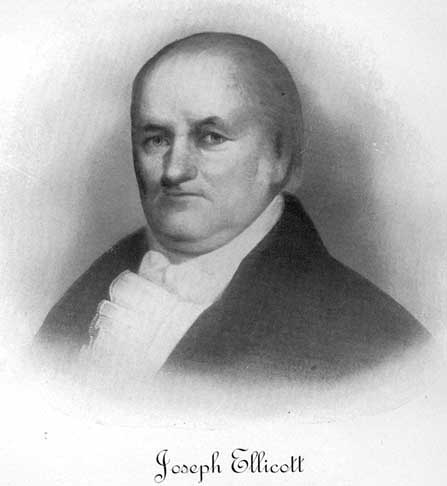 |
| 1799 |
Holland land Co.
surveyors Benjamin Ellicott, brother of Joseph, and John
Thompson
were the first to acquire land here with their purchase of 300
acres for $600,
including mill rights along Eleven Mile Creek (present Ellicott creek). From 1817-1819, Benjamin Ellicott represented Western New York in the US House of Representatives and lived in Batavia. From 1825, until his death two years later, he lived in Williamsville. Initially, he was buried in Williamsville but in 1849, was reinterred in Batavia. |
| 1799 |
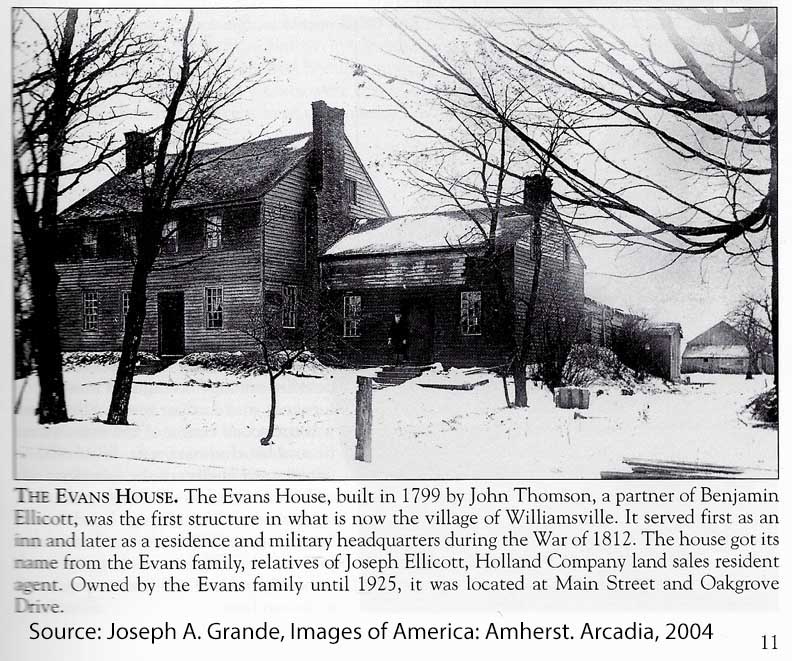 The
Evans House was later clapboarded and a large frame structure, a
wing, added to it. This became known as the Evans House.
It served as a tavern and inn as
well as the local Holland Land Company office. Demolished in
1955.
 Mural by Bertram Glover |
| 1801 |
John
Thompson built a saw mill on the east side of Ellicott
Creek. Thompson abandoned the mill in 1803. |
| 1808 |
Jonas
Williams and David
Evans (nephew of Benjamin Ellicott), also surveyors of the Holland
Land Company, purchased the 300
acre tract including Thompson's former mill property. Evans
soon
after returned to Philadelphia, but Williams stayed on to play an
active role in the development of the settlement. His efforts
resulted in the naming of the community as Williams Mills. |
| 1808 |
With
the reorganization of the Holland Purchase, the territory was made part
of the town of Clarence. Jonas Williams was elected supervisor
and Timothy Hopkins assessor at the first town meeting
in April 1808 held at the Asa Ransom tavern. |
| 1811 | "Jonas Williams built a crude [grist]
mill on the high east bank
of the Ellicott Creek, just above the falls north of Main Street. (Main
Street runs east-west, and the creek runs north-south.) Since the
dam above Main Street and the race to the mill were not built until
1834, the original mill must have operated on water taken directly
above the falls. On the Main Street front of the same
location he built a tannery and
operated it until 1819 when it was purchased by John Hutchinson."
- Sue Miller Young, A History of the Town of
Amherst, 1818-1965 The mill was a temporary structure - Williams sold it within the year. It later became known as the Dodge Mill. "Walking through Glen Park look to the other bank near the falls. Dodge Mill Foundations can be seen. The stone foundations of Jonas Williams' east mill, more popularly known as the Dodge Mill, can barely be discerned. The mill was first powered directly by the falls and later by a dam and raceway, now the main channel of Ellicott Creek. After several changes in ownership, the east grist mill was purchased in 1864 by Henry Dodge, who converted from a stone-ground process to a roller process. A fire in 1894 destroyed this famous landmark and killed Mr. Dodge, who fought in vain to save his business." - Williamsville Business Association, Historic Walking Tour, #15 (online October 2017) 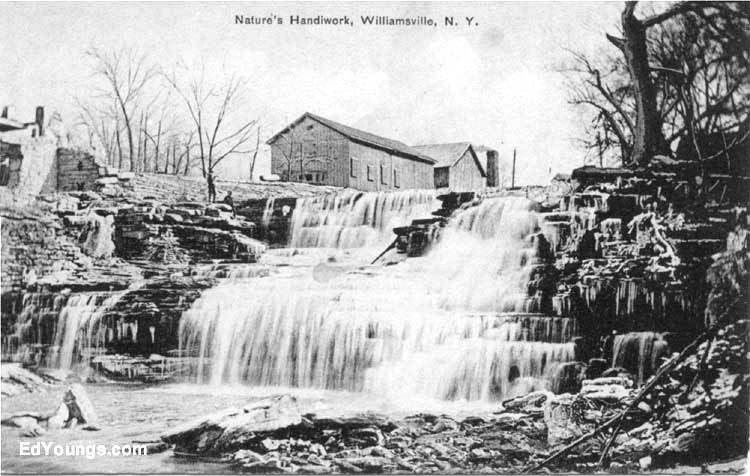 1907
photo ... Dodge
grist Mill at far left ... Building above the
falls was a tannery.
Source: Ed Young's True Value, Dodge Mill (online October 2017)  2017 photo 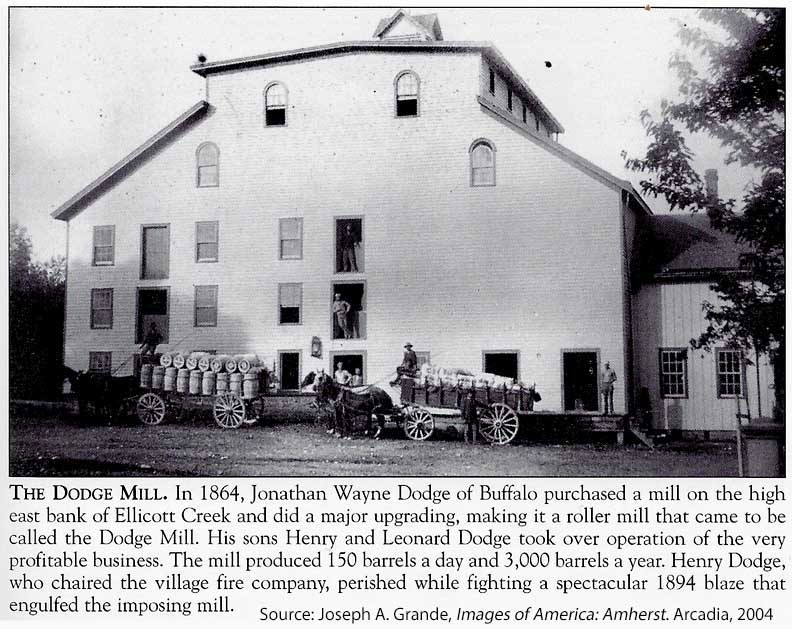 The front side of the Dodge Mill taken from what is now Mill St. "There
were once many mills along creeks in
towns and villages in Western New York during the 19th century. Across
the Glen Falls from the Williamsville Mill was the large Dodge Mill,
which produced flour through most of the 19th Century. Downstream the
1821 Reist Mill
operations included grist and flourmills, a sawmill and a hemp mill.
Three other mills were located further downstream. Little or no
evidence of any of them remains. The Williamsville Water Mill
is the sole surviving structure of an extensive early industrial
district that once existed in Williamsville. The Mill has been in
continuous water powered operation since 1811 and is one of few
remaining water powered mills in New York." - Jeffrey F. Voelkl, "Williamsville
Water Mill, Valuable History Worth Saving." Pub. in Amherst
Bee (online October 2017)
|
| 1811 |
Jonas Williams built a permanent
grist mill
on the west bank in 1811. This structure stands as
the Williamsville
Water Mill, located at 56 Spring Street. This mill is
listed as a local and national
landmark.
The water mill has functioned as a grist mill, as a cement, and as water lime, mill. The mill's overshot wheel was powered by water from Ellicott Creek via a raceway. To mill: to grind or crush (something) in a mill. Raceway: a narrow channel for water Undershot: driven by water passing from below, as a water wheel. Overshot: operated by water that flows over the top from above: an overshot water wheel Millstone: Each of two circular stones for grinding grain Hopper: A container for a bulk material such as grain, rock, or trash, typically one that tapers downward and is able to discharge its contents at the bottom. Cf.. Perot Malting Elevator hopper Water lime: Underlying the Onondaga limestone escarpment was hydraulic limestone, burned to produce a type of cement known as "water lime": a soft, white, crystalline, very slightly water-soluble powder, Ca(OH) 2, obtained by the action of water on lime: used chiefly in mortars, plasters, and cements. 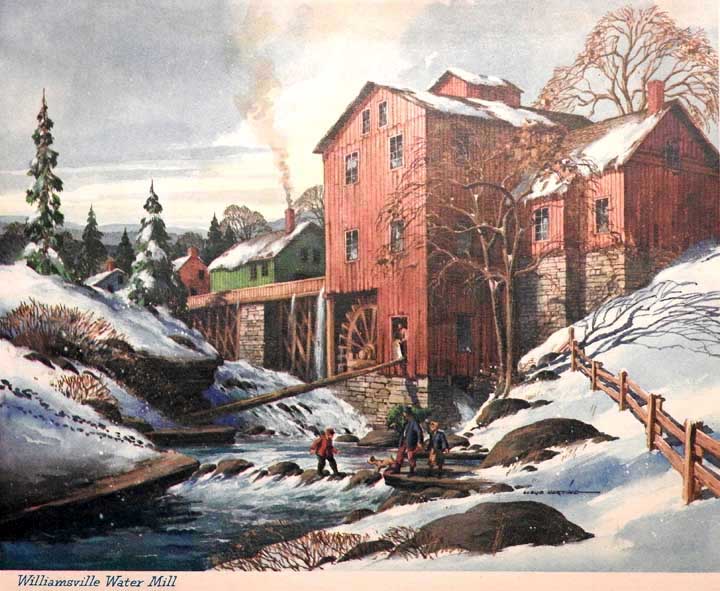 Greeting card courtesy of Dennis Dempsey  "The most substantial change was the installation of a 100 horsepower water turbine in the sub-basement to replace the water wheel. Some building improvements were made including replacement of flooring and clapboards. The section of the flume [raceway] which had extended along the back of the sawmill was abandoned some time after 1910 and replaced by a vertical concrete pressure chamber and concrete and steel penstock." - Bero Architecture P.C., Historic Structure Report - Williamsville Water Mill  October 2017 view from Glen Park |
| 1811 |
Jonas
Williams built a sawmill on the west bank near
his grist mill. He was also responsible for building a tannery, distillery, and dams and raceways to power his mills. The pioneer settlement of Williams Mills developed around these mills. |
| 1812 |
War of 1812: During the winter of 1812, General Alexander Smyth, after unsuccessfully attempting to invade Canada, retired with his army to winter quarters which were built along Ellicott Creek. Present Garrison Road is named for this encampment. The troops stayed here until the spring of 1913 when military operations started up again. Garrison: the troops stationed in a fortress or town to defend it. 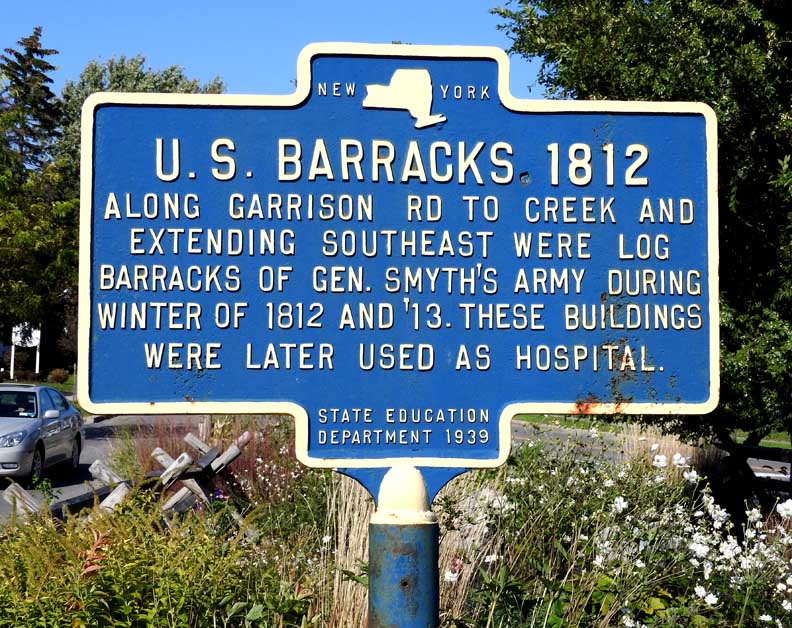 Signage at Main and Evans Sts. 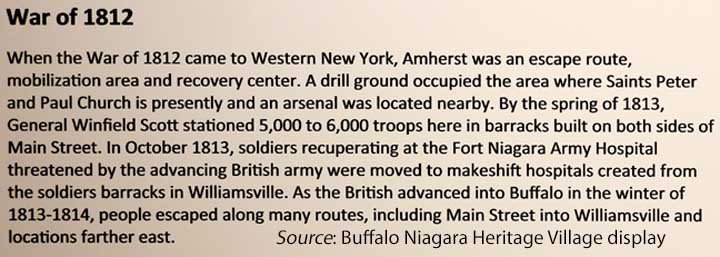 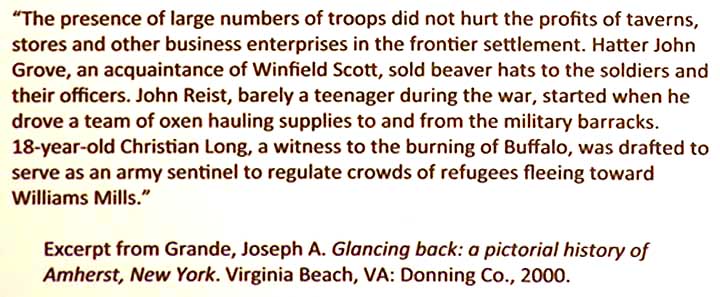 |
| 1813 |
War of 1812: In the fall of 1813 the barracks were enlarged and used as a hospital for more than 250 sick and wounded from Lewiston. Many people fled to Williams Mills upon the burning of Buffalo by the British on December 30, 1813 |
| 1814 |
War of 1812: General Winfield Scott during the War of 1812 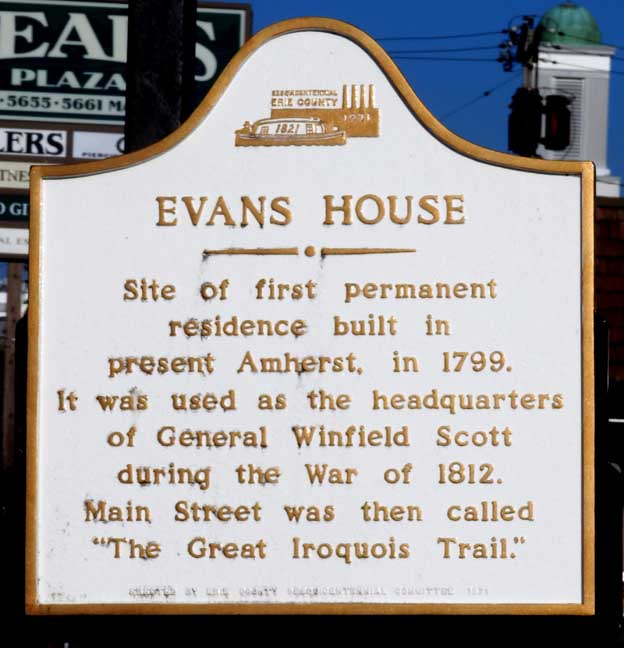 Signage
at 5665 Main Street
 Postcard courtesy of Dennis Dempsey Scott used the Evans House as his headquarters in the spring when his entire army of 5,000-6,000 men were stationed in Williamsville. For a brief time the settlement was considered the headquarters of the war when Generals Brown and Scott were here. American soldiers were said to to have been housed in log barracks erected along Ellicott Creek north of and parallel to Main Street. Military drills were held on the grounds in the present vicinity of Saints Peter and Paul Church on Main Street. The Evans House stood until 1955. Over 200 American and British soldiers who died in the US Military Hospital at Williamsville are buried in the cemetery on Aero Drive in Cheektowaga. |
| 1814 | Island
Park formed: "Island Park was formed in 1814 when Jonas Williams built a raceway from a bend in the creek (at the south end of the park) through the low-lying "creek pasture" to his mills downstream. The raceway diverted water to power mills on the east bank of the creek until the last of them fell silent around the turn of the [twentieth] century. During the early 1900s the swampy land, owned by the Gerald Long Brewing Company, was the site of a Village-maintained baseball diamond. In the 1930s as part of a WPA flood control project, the raceway was dredged and the land used to fill the swampy island creating the park as we know it today." - Carolyn Shrauger, et. al., "Williamsville, New York: Where The Past is Present," brochure published by the Village of Williamsville Historical Society, 3rd edition, pp. 44-45 "Jonas Williams sold the mills on both sides of the creek, his water rights and his remaining property on the north side of Main Street to Juba Storrs & Co., a Buffalo merchant. Storrs owned the property until 1827. As part of the purchase arrangement, Storrs was required to make modifications to the dam to lower the level of the raceway and to create a second raceway for the east side mill; these improvements had the effect of reducing flooding on the lands still owned by Williams on the south side of Main Street." - Bero Architecture P.C., Historic Structure Report - Williamsville Water Mill |
| Post War of 1812 |
The
hamlet name "Williams Mills" changed to Williamsville. |
| 1818 |
The Town of Amherst
was officially created by an Act of the Senate of the State of New
York. The town was organized from a portion of the town of Clarence and
included territory later removed to form the towns of Cheektowaga and
West Seneca. Sir Jeffrey Amherst Sir Jeffrey Amherst: Commanding general of British forces in North America during the final battles of the so-called French & Indian war (1754-1763). He won victories against the French to acquire Canada for England and helped make England the world's chief colonizer at the conclusion of the Seven Years War among the colonial powers (1756-1763). The royal government gave him a 20,000-acre land grant in New York for his service, but he never took up residence there, returning instead to England. When the War of American Independence broke out, he refused to command English forces to put down the rebels. The town of Amherst, Massachusetts, was named for him. Despite his fame, Jeffrey Amherst's name became tarnished by (disputed) stories of smallpox-infected blankets used as germ warfare against American Indians. |
| 1818 |
Timothy S.
Hopkins was chosen the first supervisor.
His son Timothy A. Hopkins was town supervisor from 1840-1843.
Hopkins Road was named after the Hopkins family.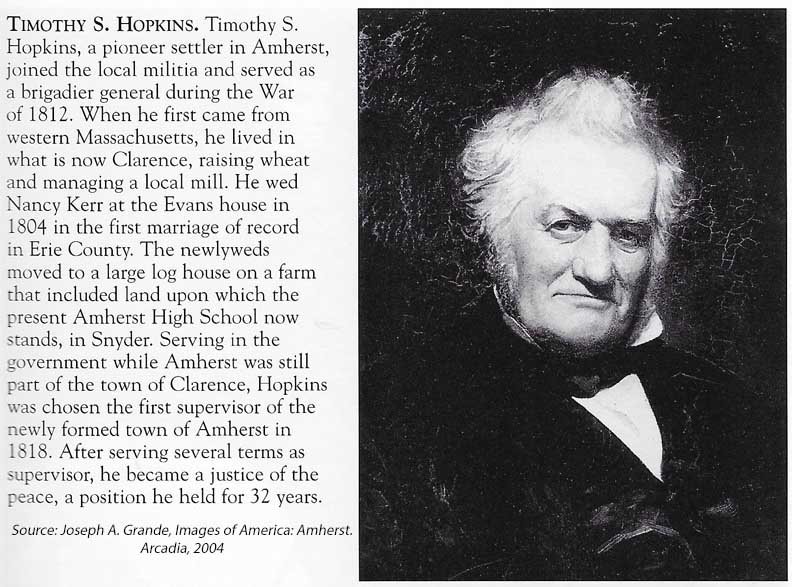 |
| 1825 |
Erie Canal
opens with Buffalo as the western
terminus, responsible for opening up new markers for area farmers and
industrialists and an influx of new settlers. |
| 1827 |
Oziel Smith acquired
the abandoned gristmill on the west bank of Ellicott Creek. Oziel Smith and later Benjamin Miller owned quarries that provided quicklime, a type of cement made from charred limestone that was used to build the Erie Canal. Limestone was used for road construction, foundations, window sills and doors, ballast on boats, and in bulkheads. Local quarries also produced fertilizer from limestone that was inexpensive for local farmers. |
| 1830s-1899 |
To
help pay for the improvements to the Buffalo Road (Main Street), a toll
booth is built on Main Street near Getzville Road. Abolished
in 1899.
  |
| C.1830 |
Stagecoaches
began operating on a
regular schedule, carrying passengers between Batavia and Buffalo, and
occasionally as far east as Albany.
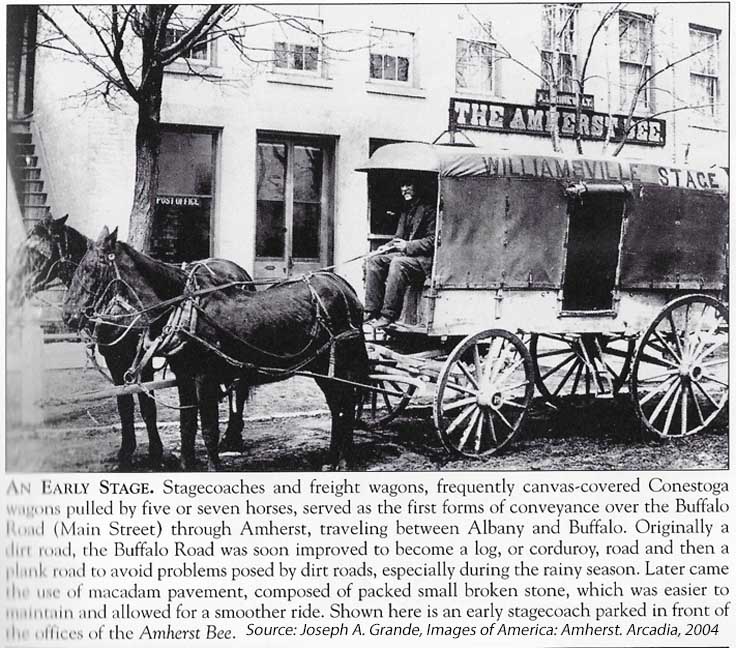 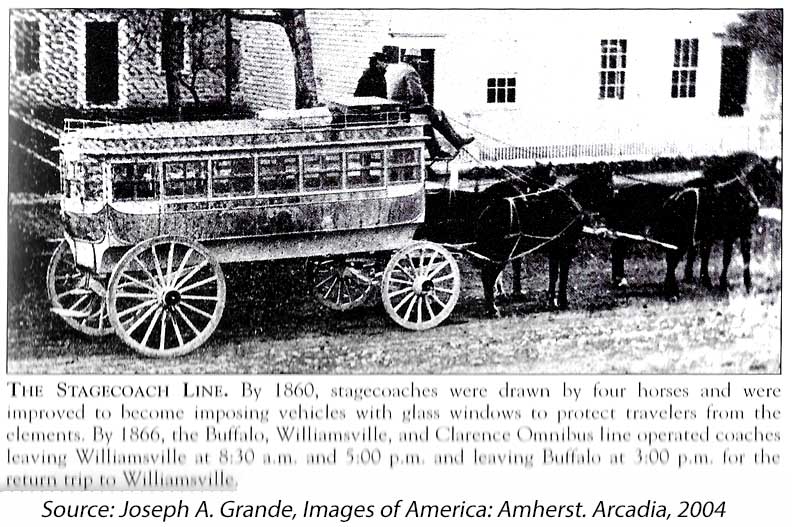 |
| 1832 |
Oziel Smith, bought up much of the business
property and all
water rights to Ellicott Creek, developing them into thriving concerns,
and completed the Eagle House, an inn and coach stop.
 Mural by Bertram Glover 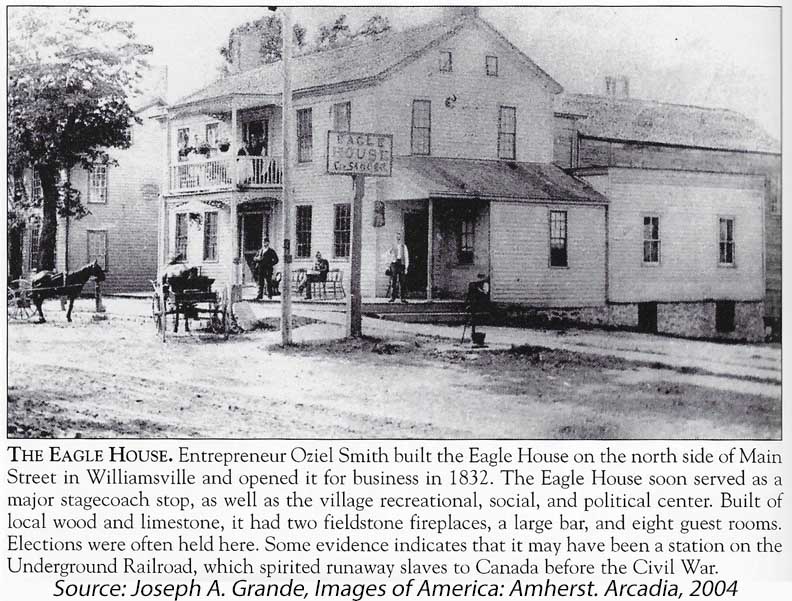 |
| 1834 |
Mennonite Meeting House built;
still standing on Main Street at North Forest Road. Today it is
the Village Meeting House & Museum. |
| 1835 |
The
Mansion House, the most fashionable hotel in Williamsville, stood
for 120 years. Located on the south side of Main Street just east of
Cayuga Road. Owned by John Hutchinson.
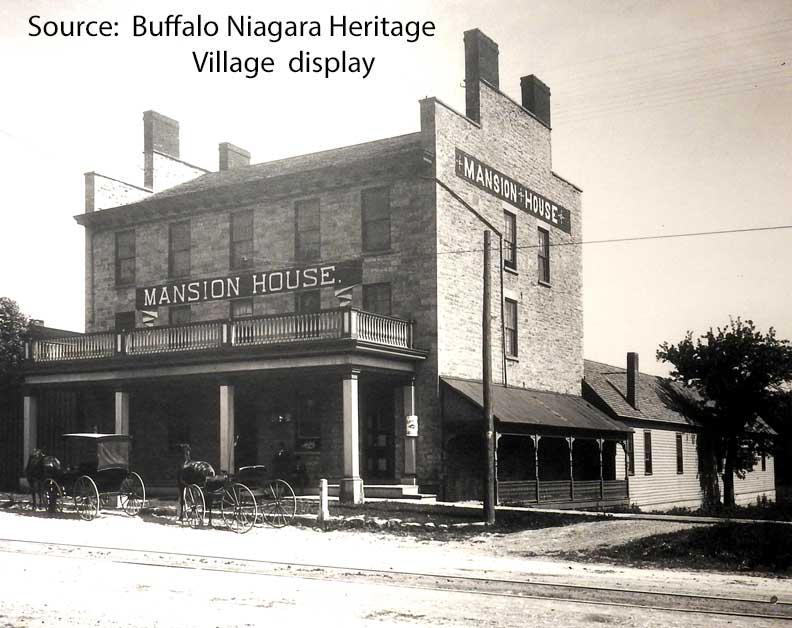 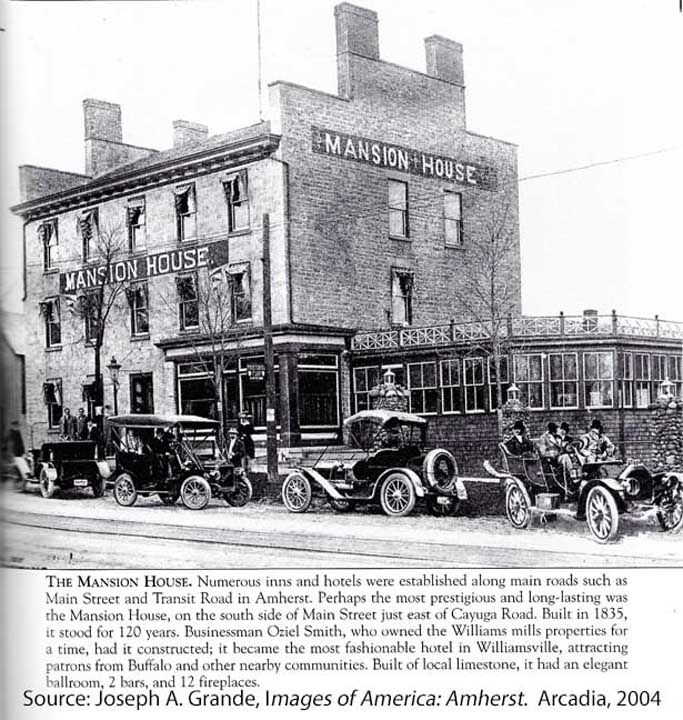  Mural by Bertram Glover |
| 1836 |
The Fogelsonger Quarry opened
in 1836,
and was Western New York's major supplier of limestone in the 19th
century. The Fogelsonger Quarry disappeared in the 1960s with the
construction of the New York Thruway and the Youngman Highway. Fogelsonger Quarry workers, c. 1890 |
| 1836 |
Catholic
missionary John Neumann (canonized 1977, the first American saint)
comes to Williamsville to found a church, SS. Peter & Paul, at 5480
Main St.
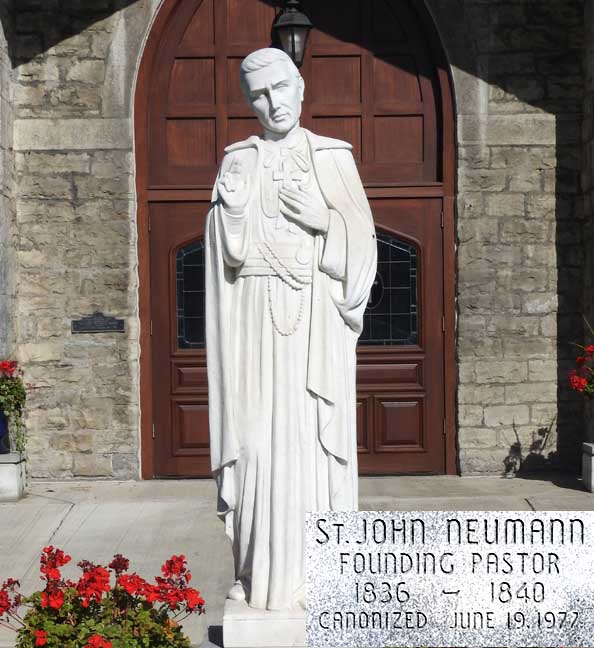  |
| 1847 |
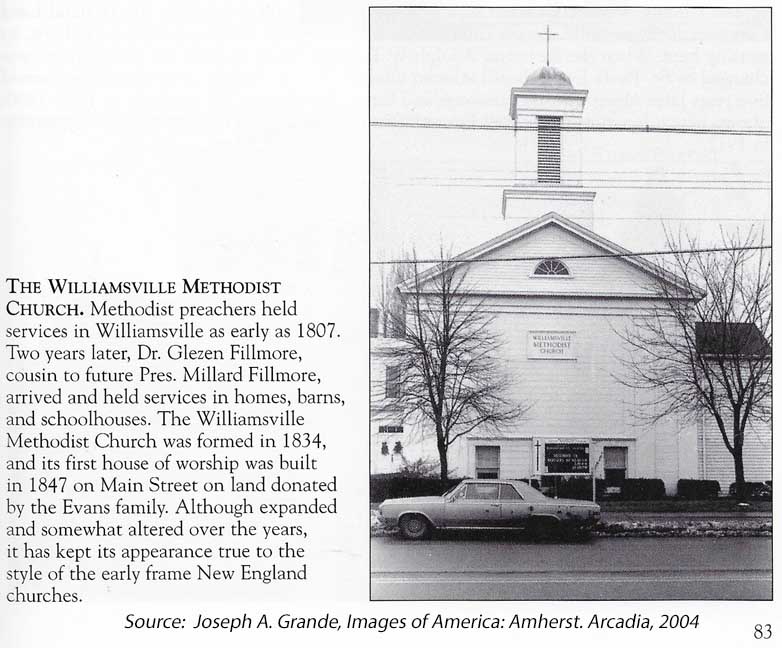 |
| 1849 |
Demeter Wehrle and his
family (daughter in photo) came to Williamsville. Wehrle Drive was named after the John M. Wehrle who took over his uncle Demeter' Wehrle's furniture and undertaking business in 1900 and was the Town Supervisor of Amherst from 1920 to 1925.  |
| 1850 |
Village
of Williamsville incorporated on July 25th, and remains the only
incorporated village in the Town of Amherst.
  Four details below:  Detail
#1
--------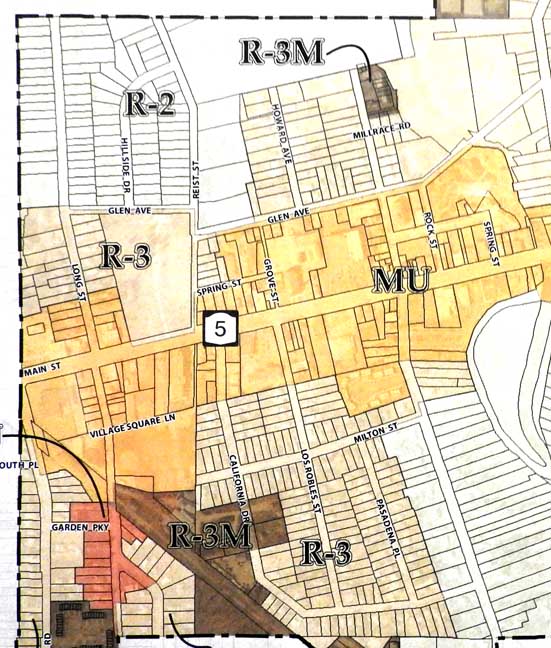 Detail #2 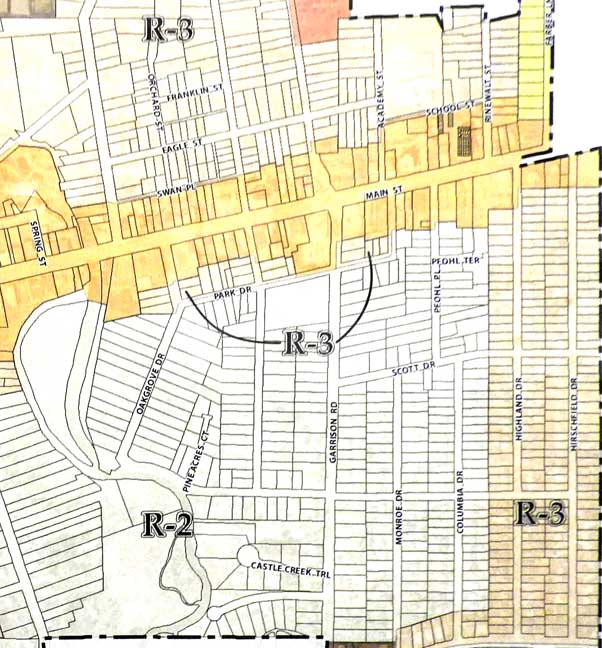 Detail #3  Benjamin Miller served as the first president. |
| 1853-1869 | Williamsville Classical Institute, 39 Academy Street, was a private secondary school, the first school in Amherst above the elementary level. It was sponsored by the Disciplines of Christ Church of Williamsville. The structure now houses Christian Central Academy. |
| 1854 |
The “Hopkins Block” or
“Brick Building,” the
tallest commercial building in Amherst containing three stories,
built at 5550 Main Street. |
| 1871 |
At 5658 Main Street, a church
was built by the Society for the Disciples of Christ
which traced its history to Williamsville in 1835. Baptism was a very
important ceremony, and many a sinner was led to the waters of Ellicott
Creek and immersed as a welcoming into the fold. Originally located at
the Northwest corners of Eagle and North Ellicott Streets, by 1870
their congregation had grown to almost 200 members. The small church
was then sold for $1000 to the Lutherans, and new property on Main
Street was acquired from Christian Rutt in 1871. The building was
completed in the same year, and along the way, many improvements were
made, including the unique baptistery still located in the elevated
“stage”. By 1976, the congregation lost membership to the point that it was disbanded, and the church sold to the village fort $1. The Village of Williamsville Historical Society (2017 official website) came to its rescue, and major renovations were completed, allowing the building to function as a museum, and gathering place for concerts, weddings, and meetings.  |
| 1879 |
Telephone lines
linking Williamsville with Buffalo installed. |
| 1882 |
Double arch stone Main Street
Bridge
replaced various wooden bridges that were destroyed by spring floods.
Built with locally quarried stone. Reinforced with steel in the
1960s. |
| 1888 |
The original Wehrle cabinet shop
was replaced by Beach-Tuyn Funeral home.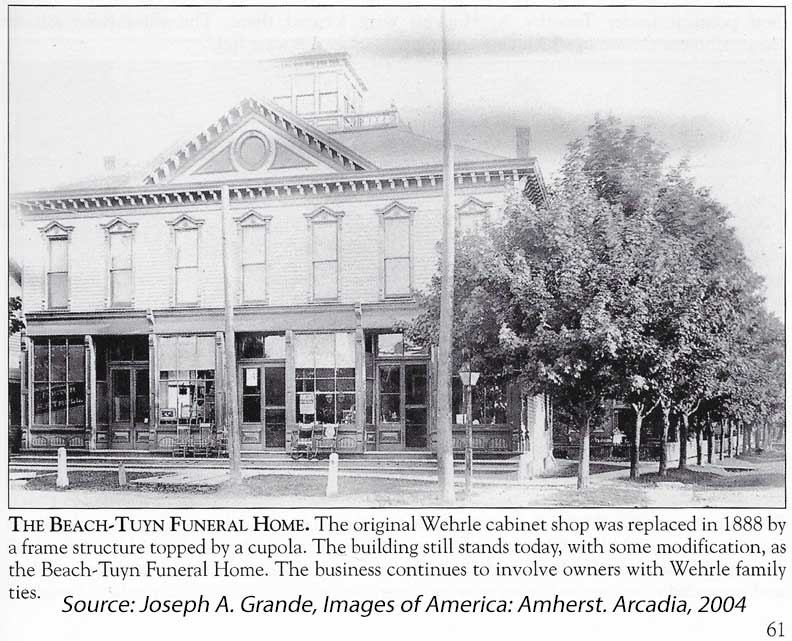 |
| 1890 |
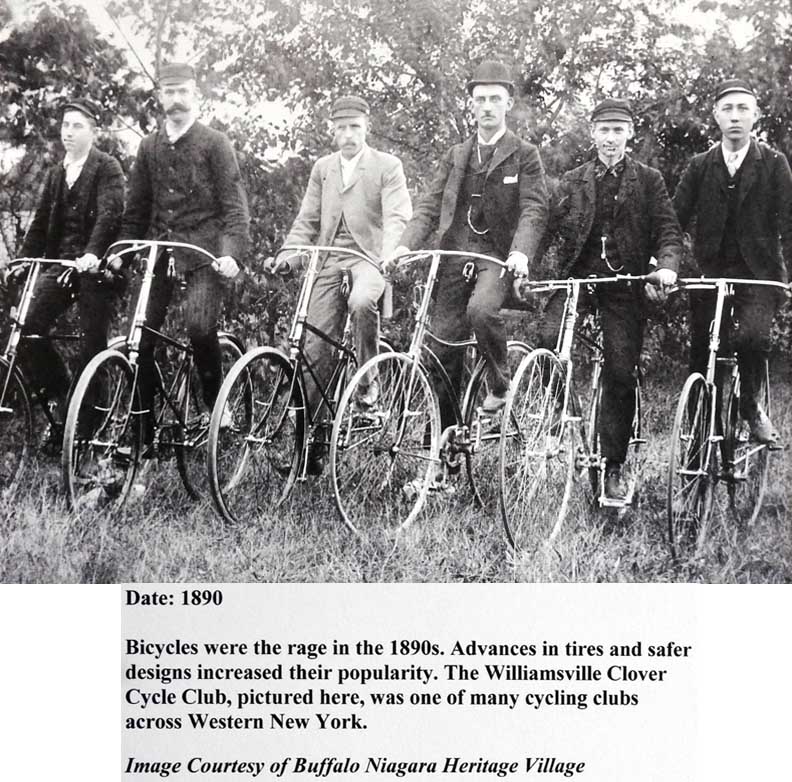 |
| 1890 |
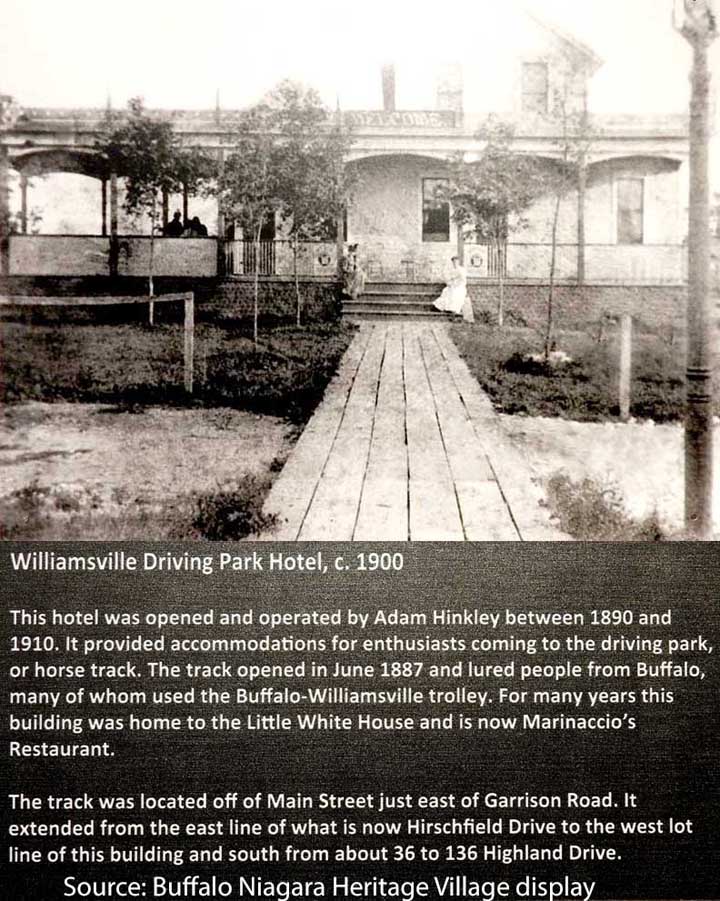 In 2017 the name of extant restaurant is Milos Restaurant (2017 official website) |
| 1893 |
 |
| 1896 |
The Lehigh
Valley Railroad, running from Depew
to Tonawanda, begins service. The Lehigh Valley RR Depot still
sands on South long Street. Passenger service discontinued in the
years following WWII. The abandoned railroad route is now used as
a recreational path. |
| 1901 |
Electric
lights installed on Main Street. |
| 1908 |
Williamsville
Hose Company reorganized as the Hutchinson Hose Company. In 1856, volunteer leather bucket brigade formed: “The Rough & Ready Fire Co. #1.” In 1895, name changed to Williamsville Hose Co. |
| 1908 |
Village Hall built in 1909 and
dedicated in
1910. Included both town and village offices, fire hall, and
village library. Razed in 1965. Architect: Cyrus Porter,
Buffalo 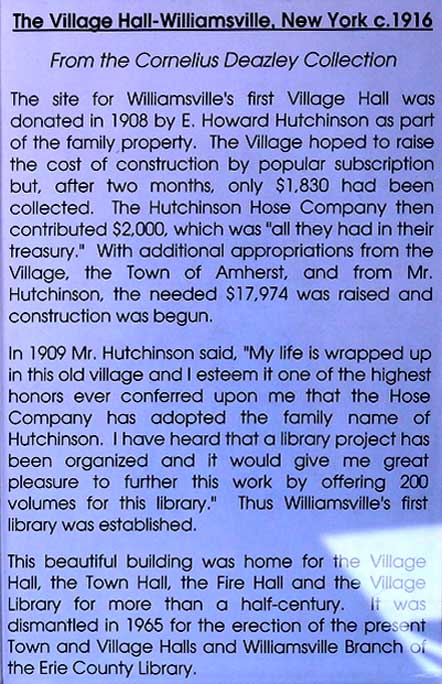 |
| 1929 |
Island
Park established |
| 1934 |
Harry Altman opened the Glen
Park Casino,
transforming a small amusement park with a diner serving dime
sandwiches and pitchers of beer for a quarter, to an entertainment
venue attracting big bands and numerous star performers. The Inferno, a popular nightspot in the park, burned on Sept. 23, 1968. Another nightclub, the Glen Casino, was destroyed on Sept.8, 1973. 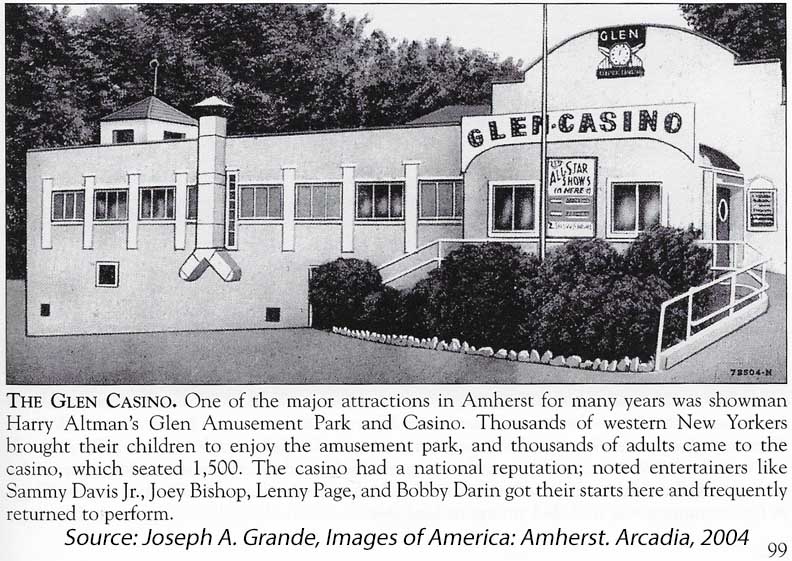 |
| C. 1943 |
Cambria Castle – Dream
Island, 175
Oakgrove Drive, built by Ignatz Oechsner who wanted to recreate a
castle like the one in the town of his birth in Germany. The castle
took 25 years to build and featured a main building, gatehouse, tower,
and coach house plus walls and bridges embellishing spring-fed ponds
and waterways. Oechsner never got to live in the castle, for he
passed away in 1942 before the work was completed. |
| 1947 |
Daniel and Grace Miller
Niederlander buy and restore Williamsville Water Mills. The
Mills were operated by Mrs. Niederlander's family from 1864-1908. |
| 1949 |
Hutchinson
Hose Company moves into new facility at 5566 Main St. |
| 1960 |
Main
Street widened to accommodate traffic and
the mature trees which once lined the street were removed. Homes
turned into professional and commercial use. |
| 1965 |
Amherst
Municipal Building and Williamsville Village Hall replace the
razed 1910 Village Hall. |
| 1969 |
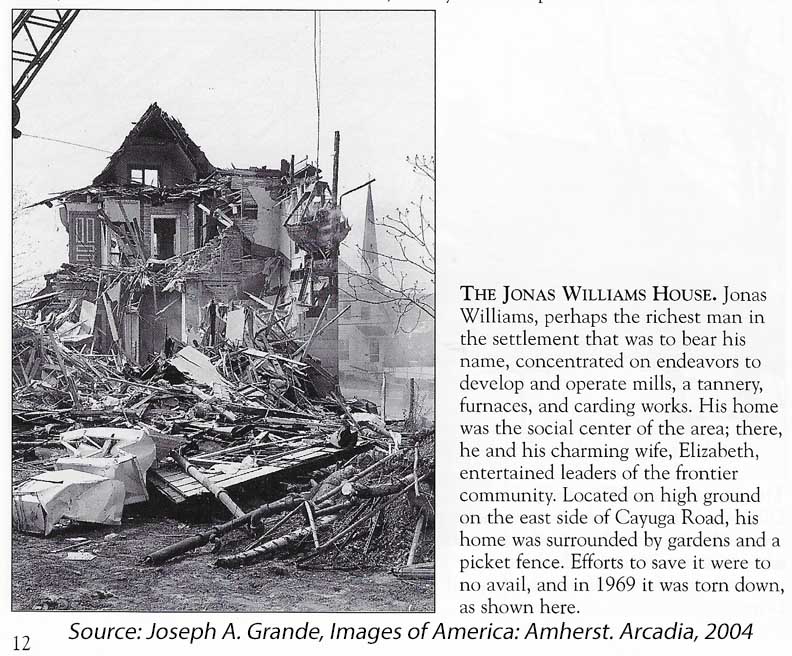 |
| 1976 |
The Village of Williamsville and
Town of Amherst acquired the 9.7 acre
parcel Glen park Amusement Park and Casino for parkland. Park
opens 1977. 2017 Photo |
Page created by Chuck LaChiusa in 2017
.| ...Home Page ...| ..Buffalo Architecture Index...| ..Buffalo History Index...| .. E-Mail ...| ..